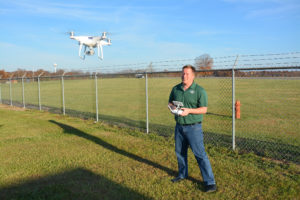By Ryan Cornelius, Co-Mo Electric Cooperative
 It’s safe to say the drone craze is here. At some point, you’ve probably seen a drone or heard one buzzing overhead during the course of the last several years.
It’s safe to say the drone craze is here. At some point, you’ve probably seen a drone or heard one buzzing overhead during the course of the last several years.
As cooperatives and other electric utilities begin to use drones for engineering and operations purposes, you may be wondering how one might apply to your job as a communicator. My cooperative, Co-Mo Electric in Tipton, Mo., took the drone plunge earlier this year. Instead of going straight to the $30,000-plus fully-equipped drone for engineering purposes, our management team decided it would be best to try out a drone on a smaller scale. For communicators and cooperatives interested in purchasing a drone, I will share our experience start to finish.
Purchasing a drone
Purchasing a drone can be tricky business for a beginner. A quick Google search of “Best Drones on the Market” will yield dozens of different products. Luckily, I had access to a couple of drone enthusiasts in our service territory. Like many, I was ready to jump right in and purchase the best drone on the market … but not so fast.
I quickly learned that flying a drone, no matter how many automatic features it’s equipped with, can be trying. I took the advice of a local realtor who uses a drone for business purposes and purchased what he called a “practice drone.” It was a Hubsan X4 Quadcopter (see: https://www.amazon.com/Hubsan-Quadcopter-FPV-Camera-Toy/dp/B00GSNWB5K/ref=sr_1_4?s=toys-and-games&ie=UTF8&qid=1508866902&sr=1-4&keywords=hubsan+x4).
The Hubsan is a smaller toy-sized drone that has a few of the features large-scale drones have. Those included a return-to-home button, screen on the controller, and HD camera with SD storage.
After weeks learning the ins and outs of controlling two toggles, I was ready to purchase something with a little more power. After discussions with a few local enthusiasts, I narrowed my drone search down to three companies: DJI, Yuneec and Syma. Like purchasing a new vehicle, there are many different models from which to choose. As a cooperative, we decided if we were going to buy a drone, we were going to get one that had all the features. We settled on the DJI Phantom 4 Pro version.
The Phantom 4 Pro has a flight time of 30 minutes per battery and comes equipped with forward, backward and downward vision systems. When activated, the vision system will ensure collisions are avoided. The model can travel close to 50 miles-per-hour and more than four miles away from the remote pilot at altitudes of up to 16,000-feet. For more, click here: https://www.dji.com/products/compare-consumer-drones?from=p4p-or-p4a.
To license or not to license
If you’re using your new drone for cooperative or any business, you need your remote pilot’s license. If you’re just doing it for fun you don’t need a license.
Shopping for your drone is easy. Studying for the license isn’t. You can find all the steps to becoming a remote pilot here: https://www.faa.gov/uas/getting_started/fly_for_work_business/becoming_a_pilot/. In my case, I went through JSI Testing Services to schedule my UAS Pilot test at a local university. Registration for the test cost $150. Once registration is complete, it’s time to hit the books.
What to study
The FAA link above comes complete with study guides, instructions and sample test questions. If you’re like me, one look at it and you’ll be heading for the hills. Luckily, there are other resources available!
We purchased the Part 107 Drone Pilot Test Prep from DartDrones. The information for the test prep can be found here: https://www.dartdrones.com/part-107-drone-pilot-test-prep-class/. The DartDrone course is $250 which grants you access for six months. It’s comprehensive and has a practice test with hundreds of questions in its bank. I found it to be the most helpful of all the study materials given. You’ll need to prepare for the following: mapping, weather, airport sectional charts, psychological issues when flying (alcohol, stress, etc.) and more. The DartDrone course covers all of this in depth. I also found a couple of free websites that covered some of the same materials as the DartDrone course, however, not as in depth. Those are:
https://jrupprechtlaw.com/part-107-test-study-guide
https://northrup.photo/free-faa-part-107-suas-drone-certification-study-guide/
What to expect on test day
You’ll need to arrive 15 minutes prior to your scheduled test time and have valid photo identification in order to sign in.
You’ll be placed in a room in front of a computer and given a book. The book will contain charts and maps that you will reference during the test. Each of the 60 questions on the multiple choice test has four answers to choose from. You will have two hours to complete the test.
It took me almost 70 minutes to complete the test. Many of those minutes were spent thumbing through the map book, attempting to find the correct map or chart that went with the corresponding questions. The proctor will let you know immediately and give you a printout stating if you passed or failed. I passed and my printout contained instructions on how to obtain my license. If you pass, you’ll have to visit the following website, create a username and password and go through the application process: https://iacra.faa.gov/IACRA/Default.aspx.
Summary
Shopping for the drone is intriguing and fun. Getting the license is work. If your co-op is heading down the drone path, it’s important to make sure you have a license. So far, we’ve created one video using our drone. You can find that video here: https://www.youtube.com/watch?v=Rlcyu_lfpWI. If you have questions, don’t hesitate to ask. Shoot me an email at rcornelius@co-mo.coop.
